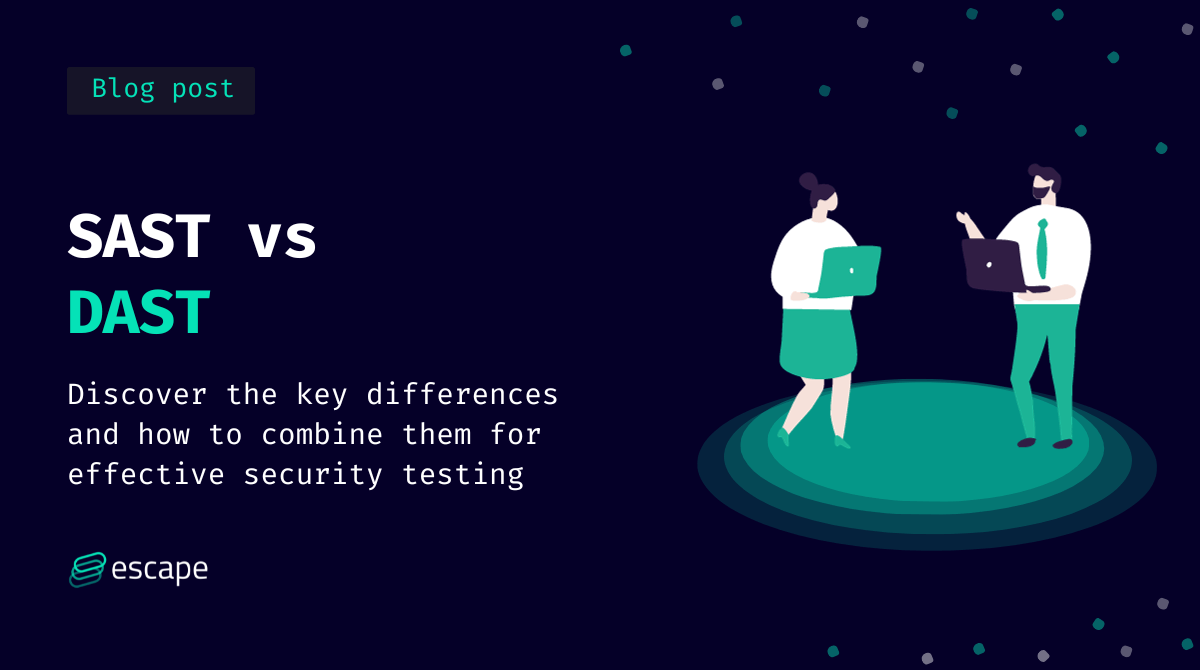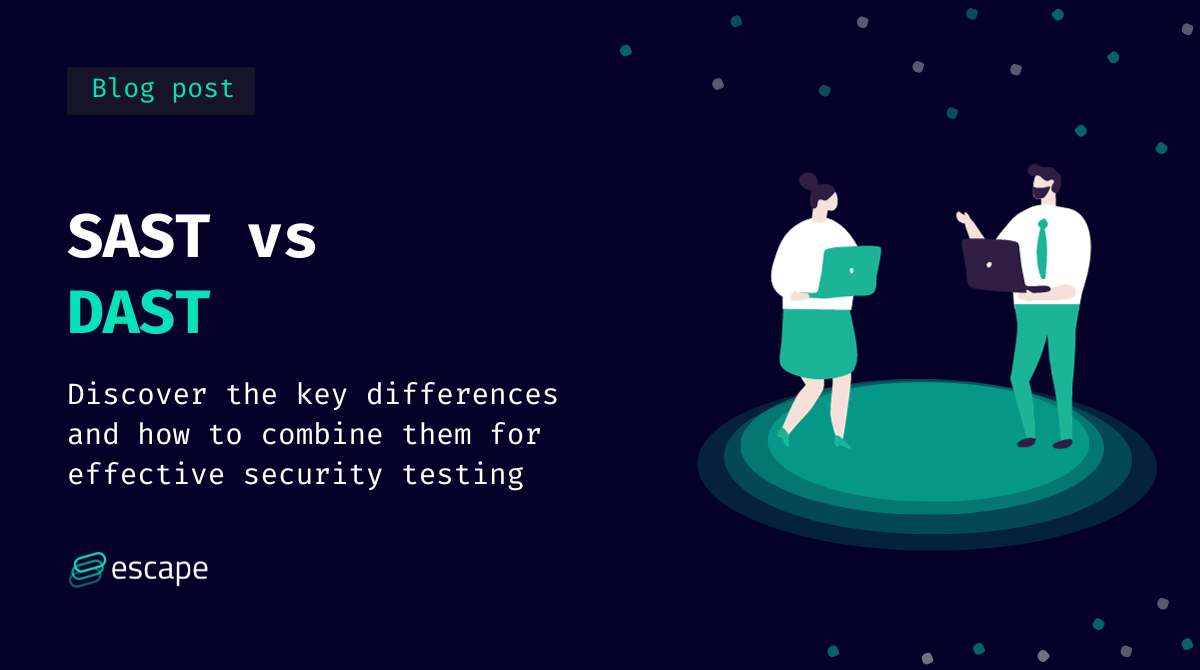
2023-11-23 18:9:4 Author: securityboulevard.com(查看原文) 阅读量:4 收藏

Should you choose between SAST and DAST? Perhaps the real question is, why not use both in your application security strategy? Let's be honest—vulnerabilities are often discovered when it's too late. No matter how well developers follow secure coding guidelines, it's impossible to keep an eye on every detail. Business teams frequently put additional pressure to deliver within tight deadlines. As pressure mounts, stakes rise, and, oops, a small mistake leads to a SQL injection in production.
That's why automating security testing before releasing applications in prod is increasingly important. Static Application Security Testing (SAST) and Dynamic Application Security Testing (DAST) tools address vulnerabilities that often go unnoticed by the most common testing methods. Both approaches aim to improve the security posture of your applications, even though they operate in distinct ways.
In this blog article, we'll explore the key differences and the untapped potential when you combine both SAST and DAST . So you can understand how you can integrate them into your application security strategy.
A quick overview of SAST (Static Application Security Testing)
What is SAST?
Let's start with the basics and describe what SAST is.
💡
SAST is a security testing method that reviews the source code of an application by examining various static inputs. Typically conducted early in the development process, it enables security teams to automatically identify vulnerabilities right after a developer submits their code to a repository. Throughout the scan, the tool follows a set of predefined rules to pinpoint and flag issues and vulnerabilities, indicating their precise locations.
Static inputs evaluated in white-box testing might include specifications, design requirements, or the application source code itself.
The method of SAST testing is often called "white-box" testing because it allows both:
SAST can be used to analyze source code for known vulnerabilities – and is also a type of white box testing.
The test will run before your code is deployed, ensuring that devs are alerted to fixes during the development phase 🛠https://t.co/CJKrQplSBp
— 🦊 GitLab (@gitlab) August 12, 2019
- Get complete view of the application's code
- Thoroughly examine potential vulnerabilities
SAST excels at identifying problems like SQL injections and cross-site scripting.
For example, for SQL injections, it assesses how user input is handled to prevent unauthorized manipulation of the database. In the case of cross-site scripting, it evaluates how the application manages user input to avoid the execution of malicious code on a user's browser.
SAST scrutinizes the code deeply, looking for vulnerabilities, security flaws, and potential weaknesses. It can identify issues at the code level, such as insecure coding practices, data flow problems, and doesn't require functioning software, so you can test your code much earlier in SDLC than DAST.
What is DAST (Dynamic Application Security Testing)
On the opposite side of SAST is DAST – Dynamic Application Security Testing. As you could deduce from the name – it performs a dynamic analysis of the applications.
DAST tools are like real-world hackers. They interact with application like someone from the outside would. In the technical language, it's called a "black-box" testing methodology: It assumes that testers lack familiarity with the internal operations of the tested software and must rely solely on available inputs and outputs. Black-box testing needs to remain dynamic. Simply because the quantity of inputs and outputs fluctuates, and the data they handle or generate undergoes constant changes.
But keep in mind, you need to have a working version of an app available for DAST testing!
At Escape, we love to provide metaphors to explain concepts to others in simpler way: DAST's real-world approach is like checking a car's safety while it's going down the highway instead of just examining the blueprints.
DAST is great at detecting multiple vulnerabilities, especially OWASP Top 10. For example, it's great at identifying weaknesses in authentication and authorization mechanisms, helping to pinpoint areas where unauthorized access may be possible, and ensuring robust user access controls. Or it can also pinpoint vulnerabilities related to how sessions are managed, including issues like session hijacking or fixation.
DAST goes beyond checking an application's internal state; it extends to testing its external environment. It's not limited to your app alone—DAST can test systems, API endpoints, web services, and even the physical and virtual infrastructure it relies on. Developers find it valuable, but the broader operations and IT community can also leverage DAST for comprehensive testing.
Now, when comparing DAST to its counterpart, SAST, it's like having two distinct tools on the same team. SAST thoroughly examines the code blueprint before the application is built, ensuring a solid foundation. On the other hand, DAST assesses how the application performs in real-world scenarios.
The exciting part is that they can work together! SAST ensures the code's integrity from the start, while DAST evaluates its performance and safety in practical situations. It's like having both brains working together to address security issues, from the earliest stages of code creation to real-world situations when the application is in action. This partnership ensures a robust protection against potential threats.
SAST vs DAST for your use case
💡
TL;DR: Choosing between SAST and DAST depends on your application's development stage and security needs. SAST is great for early vulnerability analysis, examining source code intricacies, while DAST excels in real-world scenarios, simulating external threats during runtime to identify vulnerabilities that may only appear under specific conditions. The decision should align with your application's lifecycle, with SAST suited for early phases and DAST offering a more comprehensive security plan adapted to dynamic application environments.
Determining when to use SAST and DAST depends on your specific organization's requirements.
Keep in mind that their approach differs from the start: SAST analyzes the source code for applications and identifies potential security weaknesses, typically during the development phase. DAST, on the other hand, tests live applications by simulating real-world attacks from an external source.
When is SAST most effective?
- During the development or coding stage of the software development lifecycle, before the code is compiled and tested as an executable. One of the key advantages of SAST is that it facilitates early bug detection in the large chunks of code.
- When dealing with large or complex software applications where manual testing may be time-consuming and inadequate.
- When dealing with legacy code, where it is challenging to determine the system's overall behavior or identify all the code segments that are potentially affected by a change.
When is DAST most effective?
- DAST excels when an application operates in a dynamic environment with constantly changing inputs and outputs, adapting to fluctuations seamlessly.
- The main benefit of DAST is its ability to identify vulnerabilities during runtime. Unlike SAST, DAST can detect vulnerabilities that only manifest when the application is running, such as input validation errors and access control issues. DAST can also identify vulnerabilities that result from system interactions, such as misconfigurations and integration issues.
- DAST is highly effective for testing applications after deployment, helping identify vulnerabilities that might arise in a live environment.
Even though it might seem like a reactive approach, it gives a real understanding of how the application handles attacks. Also, modern DAST tools like Escape can be integrated in pre-production cycles and into staging, so any application is tested long before it's in production.
In addition to what was mentioned above, the difference between SAST and DAST is also in the analysis scope. While SAST analyzes the entire codebase, DAST assesses the running application's exposed surfaces. SAST can identify vulnerabilities undetectable by DAST, such as hard-coded secrets and backdoors. However, DAST can identify security problems caused by server configuration and third-party components.
The table below summarises, in a compact and explicit way, the features that each solution brings to the table:
| Feature | SAST | DAST |
|---|---|---|
| Analysis before the application's running | ✅ | ❌ |
| Real-world scenario simulation | ❌ | ✅ |
| White-box testing approach | ✅ | ❌ |
| Black-box testing approach | ❌ | ✅ |
| Identifies SQL injections | ✅ | ✅ |
| Detects cross-site scripting | ✅ | ✅ |
| Requires access to source code | ✅ | ❌ |
| Operates without access to source code | ❌ | ✅ |
| Analyzes code structure and data flow | ✅ | ❌ |
| Assess vulnerabilities during runtime | ❌ | ✅ |
| Tests the application’s entire exposed surface | ❌ | ✅ |
| Comprehensive assessment of server misconfigurations | ❌ | ✅ |
| Practical evaluation of real-world conditions | ❌ | ✅ |
| Unearths issues related to runtime configurations | ❌ | ✅ |
A less radical approach to the problem
While both SAST and DAST have their unique advantages, combining them provides a more comprehensive security testing approach. Integrating these two methods enables the identification of a broader range of vulnerabilities, providing a more thorough and accurate assessment of application security.
By implementing SAST in the early stages of development, developers can identify potential vulnerabilities before any code is deployed. This allows teams to address security concerns early in the development process.
On the other hand, DAST tests the application in runtime and allows for the identification of vulnerabilities that may have been introduced after the deployment of the application. Combining both SAST and DAST ensures that the complete application is tested for security vulnerabilities, providing comprehensive coverage.
💡
73% of the security flaws cannot be found by dependency scanning and static code analysis solutions.
,Integrating SAST and DAST involves using both methods concurrently and combining the resulting reports to get a comprehensive view of the application's security posture. This can be achieved through the use of special security testing tools, which can merge the results of both SAST and DAST into a single report.
Conclusion
In conclusion, understanding the differences between SAST and DAST is critical for effective software security testing. Both methods have their unique benefits and limitations, and depending on the project requirements, one may be more suitable than the other.
At Escape we strongly recommend to combine both tools together. It's not a matter of choosing one over the other; it's about understanding and leveraging their partnership. With the increasing complexity of applications, it seems like the smartest choice. By leveraging the strengths of both methods, developers and security teams can gain greater visibility into the security posture of their applications and reduce the potential for cyberattacks.
However, if you're looking for a comprehensive DAST to test your APIs that's combined with API discovery and inventory capabilities – look no further, Escape is your go-to tool!
Escape provides full visibility into the API attack surface by extracting security signals directly from developer tools and merging this data with custom external exposure intelligence. The data is then organized into a structured inventory that categorizes APIs based on business use, data sensitivity, and security risks.
Once all data is organized, Escape sees how the API behaves in its environment and simulate attack scenarios without resorting to costly pentesting, directly into the CI/CD process as early as the build.
Escape shows alerts that represent real risks rather than simply showing issues that may pose a potential risk. Thus it is very unlikely to report false positives.
Escape provides proof of exploit for every alert uncovered. This gives developers context, validating that the vulnerabilities really exist and making it easy to remediate.
💡 Want to learn more? Check out the following articles:
- DevSecOps 101 Part 3: Scanning Live Web Applications with Nuclei
- Application security audit: an in-depth guide
- Top 7 DevSecOps Best Practices
- How to automate and secure deployment within GitLab CI with Syft and Grype
*** This is a Security Bloggers Network syndicated blog from Escape - The API Security Blog authored by Elliot Négrel-Jerzy. Read the original post at: https://escape.tech/blog/sast-vs-dast/
如有侵权请联系:admin#unsafe.sh
